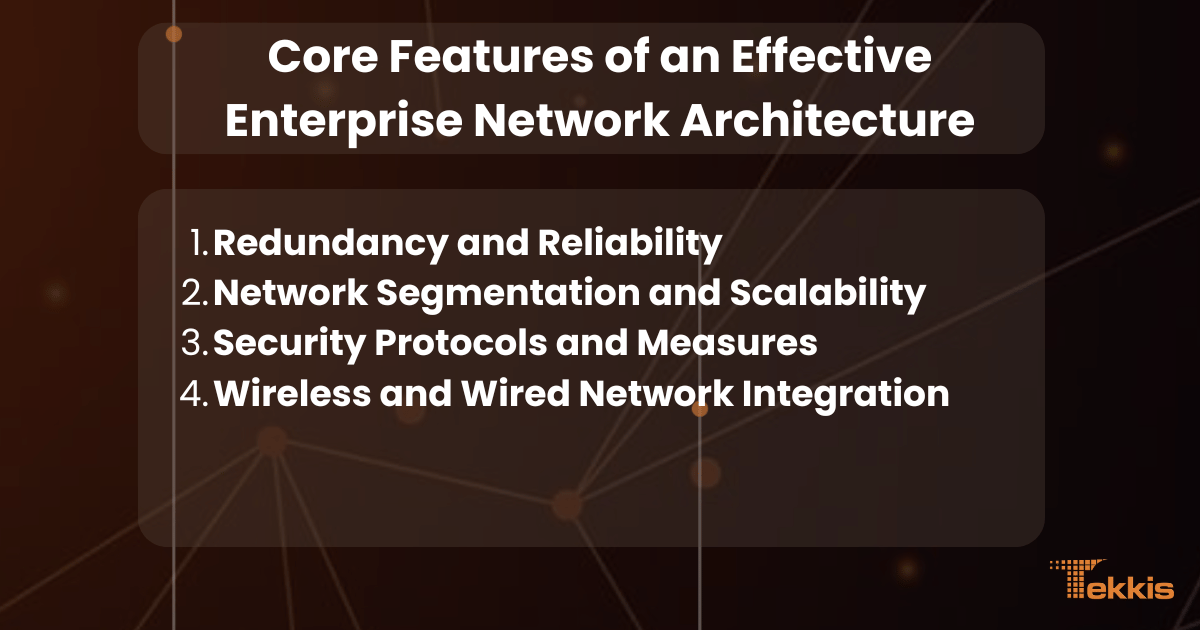What is an Enterprise Network Architecture
Enterprise network architecture includes interconnected elements essential for creating a functional system tailored to an organization's needs.
Routers direct traffic between subnets and connect internal networks to the internet, ensuring efficient data flow. Switches connect local devices and offer features like Power over Ethernet (PoE) and quality of service controls.
Security components such as next-gen firewalls and VPN concentrators are crucial and should be integrated from the beginning. Additionally, network management systems provide real-time monitoring and performance analytics, which are vital as networks become more complex.
For comprehensive network security solutions, reach out to Tekkis Cybersecurity today!Also Read:

When thinking about what makes an enterprise network, it's helpful to understand the different types that form the backbone of modern business connectivity. Each type serves specific purposes depending on organizational needs and geographic spread.
Local Area Networks (LANs) are the foundation of on-site connectivity, connecting devices within limited spaces like office buildings or campuses. These networks deliver fast data transfer—typically 1 to 100 Gbps—enabling seamless resource sharing and real-time collaboration. Today's LANs have evolved beyond simple wired connections to include sophisticated traffic management, security controls, and wireless networks supporting our mobile workforce.
Wide Area Networks (WANs) connect geographically separated locations, linking multiple LANs across cities, countries, or continents. Traditional WANs used dedicated leased lines or MPLS circuits, but software-defined WAN (SD-WAN) technology has changed the game by smartly routing traffic across multiple connection types based on what applications need and real-time network conditions. This improvement delivers better performance and cost savings.
Cloud networks represent the newest evolution, extending networks into hosted environments like AWS, Azure, and Google Cloud. These virtual networks eliminate the upfront costs of physical infrastructure while offering incredible scalability and accessibility. According to Gartner, global spending on public cloud services is expected to grow by 20.7% and reach USD 591.8 billion in 2024, showing the growing popularity of hybrid and multi-cloud strategies that has made cloud networking expertise essential for IT teams today.

Core Features of an Effective Enterprise Network Architecture
A well-designed network architecture forms the foundation of your organization's digital infrastructure. Understanding the essential components helps ensure your network can support current operations while adapting to future needs.
Redundancy and Reliability
Redundancy is the unsung hero of network architecture, creating multiple paths for data and eliminating single points of failure. Top organizations implement redundant connections, power supplies, and hardware to ensure network availability exceeds 99.99% uptime—less than an hour of downtime per year. At Tekkis, we've seen that businesses without proper redundancy can face devastating productivity losses during outages, which is why our disaster recovery services help clients implement N+1 or even N+2 redundancy models.
Network reliability goes beyond just duplicating components to include smart failover mechanisms that automatically redirect traffic when problems occur. Load balancers, clustering technologies, and software-defined networking solutions create self-healing networks that keep running with minimal human intervention. This approach is especially important for organizations in regulated industries where downtime can trigger compliance violations alongside financial losses.
Network Segmentation and Scalability
Network segmentation is both a security best practice and a performance booster. By dividing the network into logical or physical segments, organizations can isolate sensitive systems, contain security breaches, and optimize traffic flow. Tekkis's network engineering team regularly implements advanced segmentation using VLANs, subnets, and microsegmentation to create security zones that align with business functions and data sensitivity levels.
Scalability has become increasingly important as organizations face unpredictable growth and shifting workloads. Modern network architectures must support seamless expansion without disruptive overhauls or performance issues. This means designing with extra capacity, implementing modular components, and adopting standardized protocols that can accommodate future technologies. Our consulting services emphasize flexible architectures that can scale both horizontally (adding more devices) and vertically (upgrading existing systems) to meet evolving business demands.
Security Protocols and Measures
Comprehensive security is non-negotiable in effective network architecture. Today's threat landscape demands defense-in-depth strategies with multiple layers of protection. With the average total cost of a data breach reaching an all-time high of $4.88 million in 2024, organizations can't afford to treat security as an afterthought. Tekkis specializes in implementing next-gen firewalls, intrusion prevention systems, and encrypted communications while providing ongoing penetration testing to find vulnerabilities before hackers can exploit them. Our MSSP services ensure continuous monitoring and quick response when threats emerge.
The shift toward zero-trust security models represents a major change in network architecture, replacing traditional perimeter-based approaches with continuous verification of every user and device. This model operates on the principle of "never trust, always verify," requiring authentication regardless of connection origin. As cybersecurity experts, Tekkis implements zero-trust frameworks that protect sensitive data while maintaining operational efficiency, especially important for organizations with hybrid work environments and distributed resources.
Wireless and Wired Network Integration
Seamless integration between wireless and wired infrastructure has become essential as mobility transforms workplace operations. Effective network architecture must provide consistent performance, security policies, and management capabilities across both connectivity types. Our network engineering team designs unified solutions that maintain security and performance regardless of how users connect, with special attention to areas where devices frequently move between connection types.
Strategic wireless deployment requires careful planning to maximize coverage while minimizing interference. Tekkis implements wireless networks with heat-mapping, capacity planning, and spectrum analysis to ensure optimal performance. Our low voltage cable services complement this wireless deployment by establishing the high-performance wired backbone needed for today's bandwidth-hungry applications. This integrated approach ensures your network can handle more devices and increasing data demands while maintaining our signature "whisper-quiet" operation that doesn't sacrifice security or performance.
Trends and Innovations in Enterprise Network Architecture
The landscape of network architecture continues to evolve rapidly, driven by changing business needs and technological advances. Forward-thinking organizations are embracing these innovations to gain competitive advantages while addressing emerging challenges in connectivity, security, and management.
Intent-Based Networking (IBN)
Intent-Based Networking represents a fundamental shift in how network architecture is approached, moving from manual configuration to automated, intent-driven implementations. This technology translates business objectives into network policies and configurations, creating a self-operating network that continuously validates that business goals are being met.
IBN's closed-loop system of continuous verification and automated fixes aligns perfectly with Tekkis's mission of providing secure networks that operate efficiently without creating management headaches. Our consulting services now include IBN implementation planning, helping clients transition from traditional command-line configurations to policy-based approaches that better support business goals. This shift allows IT teams to focus on strategic initiatives rather than routine maintenance tasks, all while maintaining our signature "whisper quiet" operations.
Increasing Role of Artificial Intelligence (AI) and Machine Learning (ML)
AI and ML technologies are revolutionizing network architecture by introducing predictive analytics and autonomous optimization. These technologies analyze massive volumes of network traffic data to identify patterns, predict failures, and automatically optimize routing decisions. At Tekkis, we've integrated these capabilities into our MSSP services, allowing us to detect anomalies that traditional rule-based systems would miss.
Network operations have become much more efficient through AI-powered automation tools that can predict capacity requirements, identify security threats before they materialize, and troubleshoot issues before they impact users. Our cybersecurity team leverages machine learning algorithms that continuously adapt to emerging threats, providing protection that evolves alongside the threat landscape. This proactive approach to network security enables us to deliver enterprise-grade security without the constant alerts and false positives that typically create noise in security operations centers.
Impact of 5G and Wi-Fi 6/6E
The arrival of 5G and Wi-Fi 6/6E technologies is redefining connectivity expectations across network architecture. These technologies deliver theoretical speeds up to 10 Gbps with significantly reduced latency, enabling applications that were previously impractical in wireless environments. Beyond raw speed, these new standards bring dramatic improvements in device density support—crucial as IoT deployments continue to grow across industries.
Tekkis's network engineering services now include specialized planning for these advanced wireless technologies, with particular attention to their security implications. While these protocols include enhanced encryption and privacy features, their implementation requires careful consideration within the overall security framework. Our approach integrates these high-performance wireless technologies with existing infrastructure, ensuring that performance improvements don't create security gaps. We pay special attention to spectrum management and channel planning to deliver the "whisper quiet" experience that defines our brand, even in dense wireless environments.
Zero-Trust Security Models
Zero-trust security has emerged as the gold standard for modern network architecture, fundamentally changing how organizations approach access control and verification. This model assumes that no user or device should be inherently trusted, requiring continuous verification regardless of location or previous authentication. The IBM/Ponemon Institute report highlights that data breaches involving lost or stolen credentials take 292 days on average to identify and contain, making zero-trust approaches increasingly critical as remote work becomes permanent for many organizations.
Tekkis specializes in implementing zero-trust frameworks that integrate seamlessly with existing network architecture. Our approach combines microsegmentation, least-privilege access, and continuous monitoring to create security that's both robust and unobtrusive. Through our ethical hacking and penetration testing services, we regularly validate these implementations against the latest attack vectors, ensuring protection remains effective against evolving threats.
Best Practices for Designing and Implementing Enterprise Network Architecture
Successful network design requires a methodical approach that balances technical requirements with business objectives. Following these best practices will help ensure your infrastructure supports your organization's mission while maintaining security, performance, and flexibility.
Assessing Business and Network Requirements
The foundation of effective network architecture begins with a thorough assessment of both business and technical requirements. This crucial first step involves talking with stakeholders across departments to understand their current needs and future growth plans. High-performing organizations typically document functional requirements, performance expectations, security mandates, and compliance obligations before drafting network designs.
When conducting these assessments, look beyond immediate technical specs to understand the underlying business processes your network will support. For example, a manufacturing organization might need specialized low-latency networks for operational technology, while a financial services firm might prioritize security and compliance features. This business-first approach ensures your network design aligns with organizational priorities rather than forcing business processes to adapt to technical limitations.
Developing a Comprehensive Network Design
A hierarchical, modular approach remains the gold standard for network design. The traditional three-tier model (access, distribution, and core layers) provides a framework that simplifies troubleshooting, enhances scalability, and creates natural security boundaries. Modern implementations often incorporate spine-leaf architectures in data centers and software-defined networking overlays to increase agility and programmability.
Documentation serves as the unsung hero of network design best practices. Comprehensive documentation should include logical and physical topology diagrams, IP addressing schemes, VLAN assignments, and security zones. This documentation becomes invaluable during troubleshooting, onboarding new team members, and disaster recovery scenarios. Leading organizations maintain living documentation that evolves alongside the network, using automated tools to ensure diagrams and configuration records stay current as the environment changes.
Network Architecture Assessment Tool
To help organizations evaluate their current network architecture against industry best practices, Tekkis has developed this assessment framework:
| Component | Basic | Intermediate | Advanced | Your Score |
|---|---|---|---|---|
| Redundancy & Reliability | Single path connectivity with manual failover | Redundant paths with basic automatic failover | N+1 or N+2 redundancy with self-healing capabilities | |
| Segmentation & Security | Flat network with basic firewall | VLAN separation and role-based access control | Microsegmentation with zero-trust implementation | |
| Scalability | Fixed infrastructure requiring forklift upgrades | Modular design with room for expansion | API-driven infrastructure with dynamic scaling | |
| Monitoring & Management | Basic monitoring of critical devices | Comprehensive monitoring with alerting | AI-powered predictive analytics and automation | |
| Documentation | Minimal or outdated documentation | Current documentation of major systems | Comprehensive, automatically updated documentation | |
| Cloud Integration | Limited or ad-hoc cloud connectivity | Secure, dedicated cloud connections | Multi-cloud fabric with consistent security policies |
Scoring: For each component, rate your organization's current state (Basic = 1 point, Intermediate = 2 points, Advanced = 3 points)
- 6-9 points: Foundational network requiring significant upgrades to meet modern business needs
- 10-14 points: Functional network with opportunities for strategic enhancements
- 15-18 points: Advanced network architecture positioned for future growth and innovation
Hardware and Software Considerations
Hardware selection significantly impacts the longevity and performance of your network architecture. When evaluating networking equipment, consider not just current requirements but also future growth. Key factors include port density, forwarding capacity, power efficiency, and support for emerging protocols. Standardizing on consistent hardware platforms across similar roles simplifies management, reduces spare parts inventory, and streamlines troubleshooting procedures.
Software considerations have become equally important with the rise of software-defined networking and network function virtualization. Modern network design increasingly relies on controller-based architectures that separate the control plane from the data plane, enabling more dynamic and programmable environments. When selecting network operating systems and management tools, prioritize open standards compatibility, robust APIs for automation, and integration capabilities with your existing operational tools to create a cohesive ecosystem.
Optimizing for Remote Access and Mobility
The dramatic shift to remote and hybrid work models has elevated the importance of secure, high-performance remote access solutions within network architecture. A comprehensive approach includes encrypted VPN connections, multi-factor authentication, and endpoint security verification. Modern implementations often incorporate split-tunneling to optimize performance, sending only corporate-destined traffic through secure channels while allowing other traffic to flow directly to internet destinations.
Mobile device integration requires special consideration in network design, including robust wireless coverage, seamless roaming between access points, and consistent policy enforcement regardless of connection method. Advanced implementations incorporate network access control (NAC) systems that verify device compliance before granting network access, ensuring that only properly secured and updated devices can connect to corporate resources. This approach maintains security without creating friction for legitimate users.
Ensuring Robust Network Monitoring and Management
Network visibility forms the cornerstone of effective management in any network architecture. Implementing comprehensive monitoring tools that track performance metrics, traffic patterns, and security events allows for both proactive optimization and rapid troubleshooting. Modern monitoring approaches combine traditional SNMP-based statistics with more advanced technologies like NetFlow analysis, packet capture, and even AI-driven predictive analytics to identify potential issues before they impact users.
Automation has transformed network management from a manual, error-prone process to a programmatic, consistent discipline. Network design best practices now include defining the automation strategy alongside the technical architecture, identifying repetitive tasks that can be codified and standardized. This approach not only reduces human error but also speeds up change implementation, improves compliance, and frees technical staff to focus on innovation rather than maintenance. Organizations embracing network automation typically report 60-80% reductions in common configuration tasks while simultaneously improving accuracy and consistency.

Industry-Specific Network Architecture Considerations
Different industries face unique challenges and compliance requirements that significantly impact network architecture decisions. Understanding these industry-specific considerations is essential for designing networks that not only perform well but also meet regulatory standards and support specialized workflows.
Healthcare Network Architecture
Healthcare organizations face unique network architecture requirements driven by life-critical applications, strict regulatory compliance, and the need to support diverse medical technologies. HIPAA regulations mandate strict controls over patient data, requiring both encryption for data in transit and robust access controls throughout the network.
Key Considerations:
- High availability requirements: Healthcare networks typically require 99.999% uptime for critical systems supporting patient care, translating to less than 5.26 minutes of downtime annually.
- Medical device security: Legacy medical devices often lack modern security features, requiring network-level protections like segmentation and specialized monitoring to detect unusual behavior.
- Bandwidth for imaging: Medical imaging systems can generate files exceeding 1GB, requiring high bandwidth and low latency connections to support large data transfers.
- Specialized compliance: Beyond HIPAA, healthcare organizations must often comply with additional regulations such as HITECH and industry standards like DICOM for medical imaging.
Tekkis has developed a specialized Healthcare Network Reference Architecture that includes physically separate networks for clinical systems, administrative functions, biomedical devices, and guest access, with carefully designed secure interconnections that maintain compliance while enabling critical workflows.
Financial Services Network Architecture
Financial institutions operate in a highly regulated environment where network security, transaction integrity, and availability directly impact customer trust and regulatory compliance. Financial networks must support complex requirements including real-time transaction processing, fraud detection, and comprehensive audit capabilities.
Key Considerations:
- Ultra-low latency: Trading platforms and payment processing systems require microsecond response times to maintain competitive advantage and customer satisfaction.
- Multi-layered security: Financial networks require defense-in-depth strategies to protect against increasingly sophisticated attacks targeting financial assets and customer data.
- Regulatory compliance: Networks must adhere to numerous regulations including PCI DSS for protecting cardholder data and the NYDFS Cybersecurity Regulation requiring stronger cybersecurity policies and controls.
- Disaster recovery: Financial institutions typically implement geographically distributed recovery sites with real-time data replication and automated failover capabilities to ensure business continuity.
Our work with financial institutions has led to the development of our Financial Services Network Framework, which incorporates specialized security controls, ultra-redundant connectivity, and comprehensive monitoring that exceeds regulatory requirements while supporting the unique demands of modern financial workloads.
Manufacturing Network Architecture
Manufacturing environments present unique challenges for network architects, requiring integration between traditional IT networks and operational technology (OT) systems controlling industrial processes. These converged networks must maintain strict performance parameters while securing critical infrastructure against increasingly targeted attacks.
Key Considerations:
- IT/OT convergence: Manufacturing networks must securely bridge the gap between information technology systems and operational technology controlling physical processes.
- Real-time control requirements: Industrial automation systems often require deterministic network performance with guaranteed latency and jitter parameters to maintain production quality and safety.
- Harsh environmental conditions: Network infrastructure in manufacturing facilities must withstand dust, vibration, temperature extremes, and electromagnetic interference not present in typical office environments.
- Regulatory compliance: Manufacturing networks supporting critical infrastructure may need to comply with standards like NIST SP 800-171 for government contractors or NERC CIP standards for utility companies.

Addressing Common Challenges in Enterprise Network Architecture
Even well-designed network architecture faces significant challenges in today's rapidly evolving technology landscape. Understanding these challenges and implementing appropriate solutions is essential for maintaining a resilient, secure, and high-performing network infrastructure.
Managing Network Complexity
Network complexity has grown exponentially as organizations adopt hybrid infrastructures that span on-premises data centers, multiple cloud providers, and edge computing locations. This complexity creates significant management challenges, with administrators reporting that troubleshooting takes longer than it did five years ago. According to industry reports, it takes an average of 258 days for security teams to identify and contain a data breach, highlighting the critical importance of reducing complexity.
Case Study: Global Retail Chain
A global retail chain with over 1,200 locations was struggling with operational inefficiencies and inconsistent customer experiences due to a fragmented network architecture that had evolved over decades of acquisitions and organic growth. Store connectivity varied widely across regions, security policies were inconsistently applied, and troubleshooting required specialized knowledge of each location's unique configuration.
Tekkis implemented a comprehensive network standardization initiative, creating a consistent template-based architecture that could be deployed across all locations while accommodating necessary local variations. Key elements included:
- Standardized network topology with consistent segmentation across all locations
- Centralized management platform with automated configuration compliance checking
- Simplified connectivity model with regional hubs connecting to cloud resources
- Uniform security controls with centralized policy management
Results included a 42% reduction in network-related incidents, 68% faster deployment of new locations, and 37% lower operational costs for network management. Store managers reported significant improvements in application performance and reduced downtime for critical point-of-sale systems.
Security Threats and Solutions
Enterprise network security faces unprecedented challenges from increasingly sophisticated threat actors targeting expanding attack surfaces. Traditional perimeter-based security approaches have proven inadequate as remote work, IoT devices, and cloud services dissolve the network boundary. Modern network architecture requires security that's integrated throughout the environment rather than concentrated at the edge.
Tekkis's comprehensive cybersecurity services implement defense-in-depth strategies that combine multiple protective layers with continuous monitoring. Our ethical hacking and penetration testing teams simulate real-world attacks to identify vulnerabilities before malicious actors can exploit them. We've developed proprietary methodologies for implementing security controls that remain unobtrusive while providing enterprise-grade protection. This approach aligns perfectly with our mission to keep networks secure without the constant alerts and performance degradation that characterize many security implementations.
Compliance and Regulatory Considerations
Regulatory requirements for data protection, privacy, and industry-specific compliance add significant complexity to network architecture. Organizations must navigate evolving regulations like GDPR, HIPAA, PCI-DSS, and numerous industry-specific standards that impose strict requirements on network design, monitoring, and documentation. Compliance failures can result in severe penalties, making this a critical consideration for network architects.
Case Study: Insurance Company FNOL Transformation
A major insurance provider was struggling with an inefficient claims filing process that created customer frustration and compliance risks. The First Notice of Loss (FNOL) journey involved multiple disconnected systems, manual processes, and inconsistent data collection that sometimes omitted required regulatory information.
Tekkis implemented a comprehensive digital transformation of the FNOL journey, including:
- Redesign of the network architecture to support secure, real-time data integration
- Implementation of encrypted communication channels for sensitive customer information
- Automated compliance checks to ensure all required fields were completed
- Secure integration with third-party data providers for claim verification
This transformation reduced claims processing time by 17%, significantly improved customer satisfaction scores, and eliminated compliance gaps in the data collection process. The new architecture also provided complete audit trails for all transactions, simplifying regulatory reporting and improving the company's risk profile.
Preparing for Future Technological Shifts
Perhaps the greatest challenge in network architecture is designing for an uncertain future. Technologies that seemed cutting-edge just a few years ago may now be approaching obsolescence, while completely new paradigms emerge with little warning. Organizations that fail to create adaptable architectures risk costly rip-and-replace scenarios when current solutions can no longer support business requirements.
Tekkis's approach to future-proofing networks focuses on building flexible foundations that can accommodate technological evolution. We implement modular designs that allow components to be upgraded independently, adopt open standards to avoid vendor lock-in, and create abstraction layers that isolate applications from underlying infrastructure changes. Our disaster recovery planning services extend beyond traditional backup and recovery to include technology migration strategies that help organizations transition smoothly as new capabilities emerge.
By implementing software-defined technologies wherever appropriate, we create programmable infrastructure that can adapt to changing requirements through configuration rather than replacement. This approach allows our clients to embrace innovations like AI-driven operations, IoT deployments, and edge computing without wholesale architecture redesigns. As the pace of technological change continues to accelerate, this flexibility has become essential for organizations seeking to maintain competitive advantage while controlling costs.

Conclusion
Enterprise network architecture is essential for aligning business strategy with technological capabilities, serving as the backbone of organizational success in the digital age. Effective network design involves careful attention to various factors, including physical components, logical structures, security, and management.
Successful enterprise networks prioritize business objectives, resilience, scalability, layered security, and efficient automation. They do more than connect devices; they foster innovation, adapt to new work patterns, protect data, and embrace emerging technologies.
Organizations that view their network architecture as a strategic asset gain significant competitive advantages, experiencing fewer disruptions and better adaptability. Conversely, those with fragmented approaches struggle to seize new opportunities.
As technologies like AI, 5G, edge computing, and IoT evolve, the need for thoughtful network architecture will grow. By applying the principles and best practices discussed, organizations can create robust network foundations that meet current needs and ensure future success.To learn more about how Tekkis can help transform your network architecture into a strategic business asset, contact our team of specialists for a personalized consultation and assessment of your current environment.



